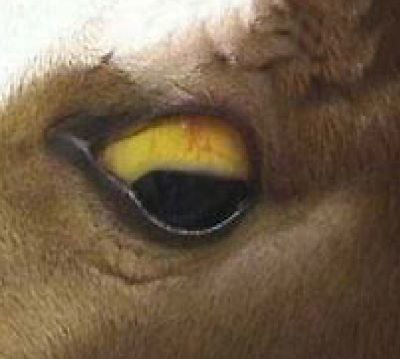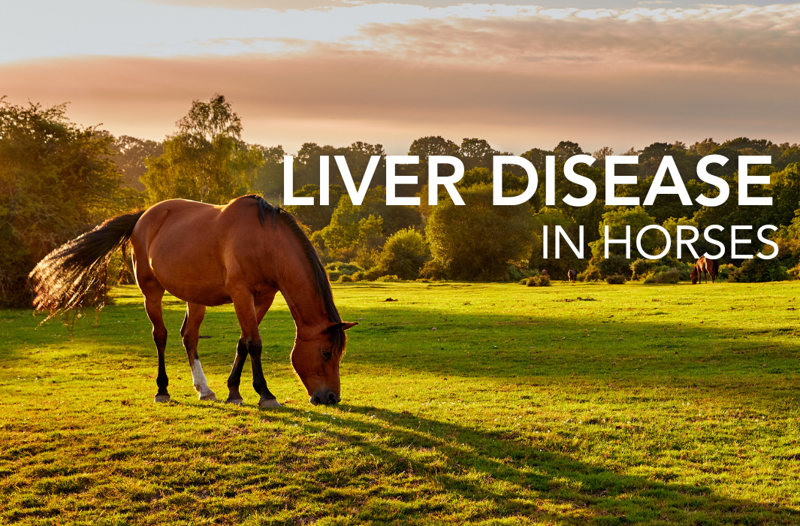What does the horse’s liver do?
The liver is one of the largest organs in the horse’s body, accounting for 1% of its total bodyweight. It is involved in many different processes and is the only organ that can significantly regenerate after damage.
A key function with respect to digestion is the metabolism and processing of carbohydrates, proteins and fats:
Carbohydrates –
The liver plays a major role in regulating blood sugars. It can store carbohydrates as glycogen, releasing it into the blood as glucose if blood sugar levels drop too low.
Fats –
Digested fats are processed in the liver before being transported to other sites for use. The liver breaks fats down to acetate for energy metabolism, packages fats into lipoproteins for transport through the blood, synthesises cholesterol for cell membranes and hormone production, and it also produces and secretes bile acids into the intestine to break down dietary fats for digestion and absorption.
Protein –
The liver can convert some amino acids into others, so can synthesise non-essential amino acids. It also converts excess dietary protein into fats and glucose for energy production by removing the nitrogen group, which is then excreted in the urine as urea.
Various nutrients including vitamins A, D, E, K and B12, and minerals such as iron and copper are stored in the liver to be packaged and delivered to other tissues as necessary. In contrast to humans, horses can make their own vitamin C from glucose in the liver.
Other functions of the horse’s liver include:
Hormones – The liver makes various hormones including IGF-1, responsible for cell growth, angiotensinogen, which plays a role in regulating blood pressure, thrombopoietin, for stimulating the bone marrow to make red blood cells, and hepcidin, which regulates iron absorption and transport. It’s also involved in metabolism and function of thyroid hormones, steroid hormones such as oestrogen, progesterone and testosterone, and others including insulin.
Immune function – A significant amount of lymph fluid is made in the liver, and it also contains immune cells that remove bacteria and other pathogens from the blood.
Detoxification – One of the liver’s best-known roles, it is responsible for removing toxins and metabolic waste from the blood, either through enzymatic modification to make them water soluble after which they can be excreted through urine, or by being broken down into inactive forms which are then secreted with bile and passed out in the faeces.
Including all these processes, the liver has over 500 functions, which goes some way to demonstrating its vital importance in the horse’s body. Due to the wide range of functions, liver disease symptoms can vary. As the liver can function without being at full capacity, many cases of liver disease don’t show obvious signs until they are approximately 70% damaged so blood tests performed by a vet are a key diagnostic tool for early detection.

horse with jaundiced eye
Signs and symptoms to watch out for include:
- Jaundice, yellowing of the whites of the eyes or it can be seen in the mouth and gums of paler skinned horses.
- Loss of appetite and / or condition.
- Difficulty swallowing
- Diarrhoea and / or discoloured urine.
- Skin sensitivity to sunlight, causing itching, inflammation or redness and fluid build-up under the skin.
- Depression or lethargy.
- Behavioural changes including persistent yawning, head pressing, lack of co-ordination, walking in circles, and either increased friendliness or aggression.
The main risk factors for liver disease are poisoning through ragwort and other plants which have high levels of pyrrolizidine alkaloids as well as certain clover varieties, mycotoxins produced by mould spores in hay, feed or bedding, or certain types of water-borne algae. The liver can also be compromised by certain bacteria, viruses and parasites.
Obesity, poorly controlled Equine Metabolic Syndrome (EMS), and insulin resistance can contribute to fatty liver disease, in which the function of the liver is compromised by excessive fat storage. Conversely, rapid weight loss after obesity can cause a related liver disorder, as the liver attempts to metabolise fats rapidly to provide a high amount of energy for other physiological processes.
Other nutritional considerations would include minerals obtained through the diet. As iron and copper are stored in the liver, over supply of these minerals can cause problems in the long term as can selenium and in rarer cases, zinc. Most forage-based diets provide more than adequate iron, so over supplementation can be a concern if feed and supplements also contain this mineral.

Ragwort (Senecio jacobaea) in a field
Preventing liver problems
Liver disease can be difficult to diagnose and treat, so prevention is always better than cure. Management strategies to avoid the onset of problems could include:
- Ensuring ragwort and other poisonous plants are removed from fields.
- Avoid feeding mouldy hay or haylage, and if providing large round bales of hay ensure they are kept dry and eaten quickly.
- Check all forage is free from poisonous plants.
- Implement a yard-wide parasite control strategy including faecal testing, worming and poo picking. If in any doubt or unsure speak to a vet to devise an appropriate strategy.
- Use feed and supplements from UFAS accredited and audited companies, ensuring it is kept clean, dry and secure from pests.
- Practise good feed hygiene; regularly cleaning water troughs and buckets, feed buckets, stirrers and scoops as well as any storage bins. Ensure storage bins and scoops are completely dry before they come back into contact with dry feed.
- Maintain a healthy weight.
- Ensure a balanced diet, with adequate provision of micronutrients and avoiding over supplementation of minerals. If in any doubt, contact a registered equine nutritionist to discuss your horse’s overall diet and weight management.
In conclusion, liver disease in horses can occur for a variety of different and unrelated reasons, with symptoms being similarly diverse. As the liver can still function without being at full capacity, symptoms may go unnoticed for a long period of time and are often only truly detectable through bloodwork and other diagnostics performed by a vet. Early treatment is instrumental in full recovery which, thanks to the regenerative capacity of the liver, is possible in many cases that have not yet become advanced. As early intervention can be difficult due to the fact symptoms are not always obvious, preventative management strategies should be a key part of routine care.
For any advice or questions you may have, please don't hesitate to reach out to our expert nutrition team. You can call 0800 585525 Monday-Friday 8:30am-5:00pm. Email [email protected], or send us a DM on social media.


